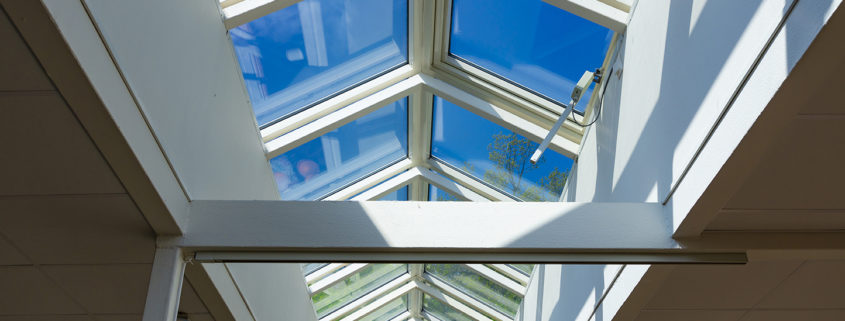Skylights are a great addition to the roof system of a commercial building. They are becoming more common not only for large commercial structures but also in schools, libraries, and hospitals. Allowing in natural light increases the building’s energy efficiency by reducing the use of artificial light.
Natural light also comes with added health benefits, too as it increases the health and productivity of the occupants in the building. Natural light even helps ward off symptoms of seasonal affective disorder (SAD) by allowing more light in during the fall and winter months. While there are many benefits, there are also common commercial roofing skylight issues.
Skylight installation, as with any building component, comes with its own set of challenges and concerns. Learn more about common skylight problems and how to address them.
Common Skylight Issues and Concerns
One very common problem, which is easily remedied, is the buildup of dust and grime on the interior surface of a skylight. Excess dirt can eventually damage the surface and compromise the skylight’s energy efficiency. Make sure that the skylights in your commercial building are cleaned regularly. If there is no cleaning schedule for your skylights, get one started!
Another common problem concerning skylights is, of course, leaks. Skylight leaks will usually be in one of two places: the curb flashing that creates the seal between the skylight and the roofing material and the skylight material itself.
Leaking Curb Flashing
Leaks around the curb flashing of a skylight are more common when the skylight was installed on a flat roof of an already constructed building. Without proper drainage, ponding can occur around a skylight (possibly due to clogged gutters or sagging roof membrane). Water can eventually degrade the sealant around the skylight and penetrate the roof surface, causing roof leaks as water seeps through.
Cracks or Breaks
Skylights have to be constructed with very durable material to withstand constant exposure to outside elements. Large skylights are typically constructed using laminated safety glass, fiber-reinforced plastic (FRP), or cellular polycarbonate glazing (CPG). Both CPG and glass won’t discolor over time, so they retain the same look through the skylight’s life cycle.
Sometimes, an extreme weather event can dislodge skylight panels. This is usually due to debris thrown by high winds, such as those associated with a hurricane, tornado, or even a strong hailstorm. However, it can also be a result of improper installation of the skylight panels.
Remember that the longer you wait to address problems and leaks with your skylights, the more money you will spend from energy loss in your building. You may also spend more money on repairs, as problems that may have started small begin to escalate.
Skylight Maintenance
In order to have your skylights function as intended at all times, they should be inspected as part of your regular roof maintenance schedule. Regular roof inspections can increase the lifespan of your entire roof system and diagnose roof issues before they become major problems. Skylights or not, roof inspections are always a worthwhile addition to your building’s maintenance schedule.
The roofing contractor that performs your roof inspections should inspect the flashing for buckling or breakage as that is a telltale sign of water damage. They should inspect the metal frame holding the glass or plastic panels in place and make sure it’s secure, paying close attention to the sealant itself. After sitting in the constant sun and rain, sealant can become brittle and cracked.
As the owner of the building, you should make note of any condensation on the inside of your skylight. This is a strong indication that there is an opening somewhere around your skylight. If this or any of the previous issues are present, you’ll require skylight repair.
Skylight Installation
Most skylight systems are far more complicated than they first appear, so installation is only a job for the most qualified. Keep in mind that there are two types of skylight installations: those that are assembled on the job site and those that arrive pre-fabricated.
If you are dealing with a pre-built skylight, it will require a crane on-site for installation. The advantage of this type is that less time and labor are involved because the pre-built unit can easily be set into place and installed. Assembly at the construction site can cause delays for other projects that can’t begin until the skylight is fully installed.
Your building will determine the performance criteria your skylights need to meet: structural integrity, fire resistance, and condensation resistance, just to name a few.
Skylight Safety
To make your roof and skylights as safe as possible, there are several safety measures to implement. First, never allow anyone on the roof who isn’t qualified to be there. Access to the roof should be limited to roofers or other personnel from your chosen roofing company. Next, never walk on a skylight. Although skylights are strong and capable of withstanding harsh weather conditions, they are not tested or rated for human impact.
Last, it is a good idea to place guardrails, fencing, or some other type of protective structure around the skylights to keep them secure.
We’ll Solve Your Skylight and Roof Problems
Skylights have potential issues, but as long as they are properly installed and maintained, the benefits far exceed the drawbacks. They’re increasingly popular in new construction and can brighten up the gloom of an old building. Manage your commercial roofing skylight issues with a trusted roofing company. If your skylights are leaking, or if you need a commercial roof repair or roof replacement, don’t hesitate to contact TEMA Roofing Services today!





